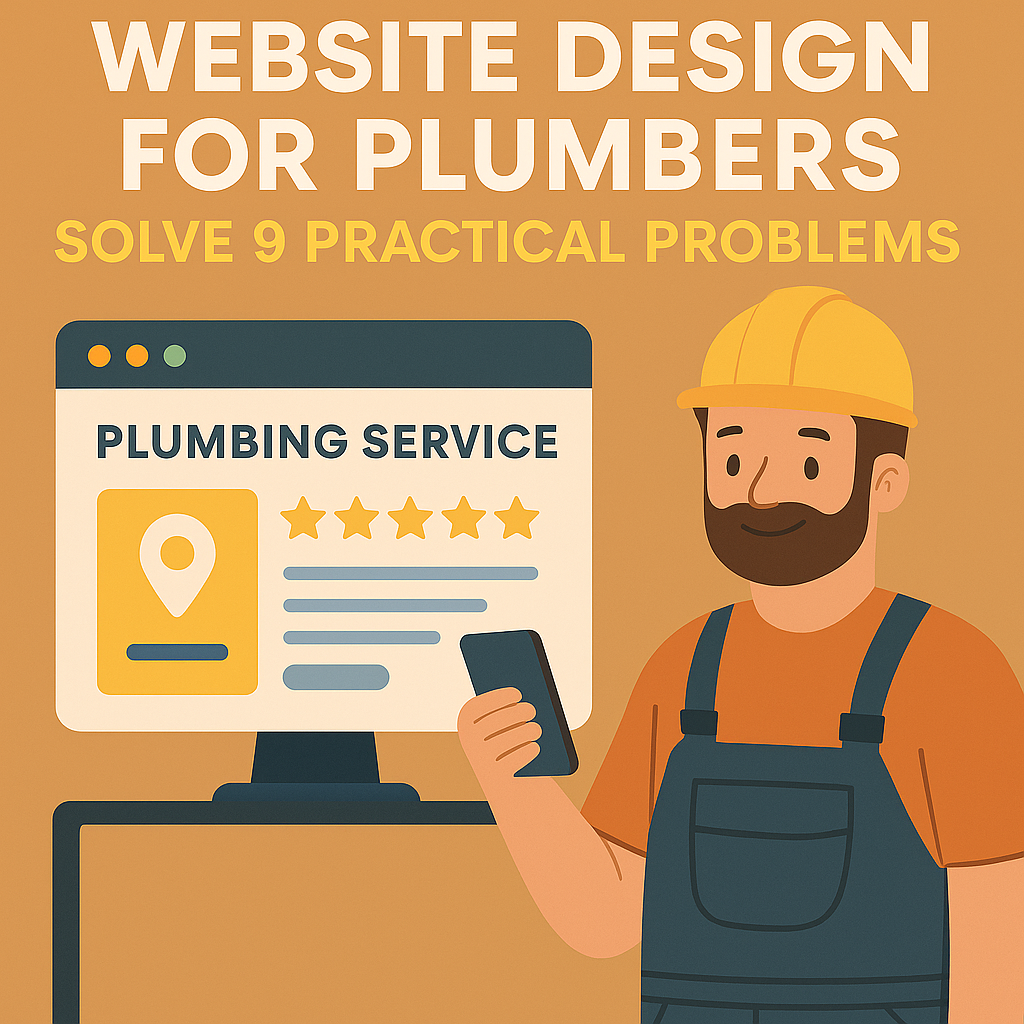Best online marketing strategies for UK construction companies in 2025
Construction Companies Face Several Challenges When Using Online Marketing Strategies
For construction companies, online marketing is no longer a “nice to have”—it’s a requirement. From builders looking for steady streams of domestic projects to developers securing large-scale investors, digital visibility often determines whether the phone rings or stays silent. Yet, while the potential is enormous, many firms find themselves hitting walls when trying to market effectively online.
Unlike industries with straightforward products, construction businesses must juggle long sales cycles, diverse audiences, and high-value but high-risk projects. This creates unique marketing challenges that generic strategies don’t solve.
Key Challenges:
-
Complex Audiences
A roofer chasing emergency repair jobs has completely different marketing needs from a developer courting investors or an architect promoting design-led services. Creating campaigns that resonate with multiple audiences at once is difficult—and often results in diluted messaging.
-
High Competition in Local Search
Google is flooded with “builder near me” ads and listings. Without hyper-local SEO, GBP optimisation, and reputation management, even established firms are drowned out by aggressive competitors who spend heavily on ads.
-
Low Trust Barrier
Construction involves significant investment. Clients want to see proof of competence, insurance, certifications, and reviews. Marketing without visible trust signals risks making you look unproven, no matter your track record.
-
Long Sales Cycles
Home extensions or commercial developments aren’t bought on impulse. Marketing strategies must account for nurturing leads over months—often with multiple stakeholders involved. Few firms build this into their digital funnel.
-
Poor Conversion Infrastructure
Many firms spend thousands driving clicks to websites that lack clear CTAs, quote tools, or booking systems. As a result, valuable traffic leaks away, costing more in ads and wasted opportunities.
-
Underused Visual Content
Construction is highly visual, but many businesses rely on text-heavy adverts or static images. In 2025, short-form video, drone footage, and CGI walk-throughs are essential for standing out online.
-
Limited Measurement & Tracking
Without robust analytics, construction firms can’t tell whether enquiries came from organic SEO, LSAs, or paid ads. This leads to poor decision-making and wasted budgets.
Why This Matters
If these challenges aren’t addressed, marketing spend turns into a sunk cost instead of a growth engine. Competitors who solve them consistently appear more professional, trustworthy, and accessible—winning contracts by default.
That’s why construction companies need strategies built for their industry: ones that combine local SEO dominance, conversion-focused web design, video-first marketing, and precise paid media targeting with smart automation and trust-building reputation systems.
Strategy 1: Google Business Profile 2.0 + Local Services Ads (LSA)

Why This Matters
In 2025, Google Business Profile (GBP) and Local Services Ads (LSA) are no longer optional add-ons—they’re the front door to your business. Before clients even reach your website, they’re checking Maps, reviews, and Google’s own lead-generation tools. Whether it’s a homeowner needing an emergency roofer or a property developer comparing contractors, most enquiries start with Google’s local ecosystem.
This matters because the top three results in Maps and LSAs soak up the majority of clicks. If your profile isn’t optimised, or you’re not verified for LSAs, your competitors are taking those calls—often at the exact moment customers are ready to book.
The Problem
The construction sector is full of businesses with half-complete or outdated Google profiles. Common issues include:
-
Wrong categories (e.g., a roofer listed as “Home services”).
-
No service list, meaning you don’t show for “emergency electrician” or “loft conversion contractor”.
-
Poor or missing photos, leaving your profile looking neglected.
-
Few reviews or worse, unanswered negative reviews.
-
No LSA verification, which means you’re invisible in the “Google Screened” box at the top of results.
Clients interpret these gaps as red flags. Even if you’re the most skilled contractor in town, a weak profile makes you look less trustworthy than competitors who’ve optimised theirs.
The Solution
Step 1: Fully Optimise Your Google Business Profile
-
Builders: Use “Builder” as your primary category. Add services like Loft Conversions, Extensions, Renovations. Upload albums by project type (e.g., “Kitchen extensions in Manchester”).
-
Roofers: Add “Emergency roof repair” as a service. Enable the Messaging feature so people can text you directly. After storms, upload before/after repair photos with captions including the town name.
-
Electricians & Plumbers: Add services like 24/7 Emergency Callouts, EICR Testing, or Boiler Installations. Keep your hours accurate—mark yourself as “Open now” if you handle emergencies.
-
Developers & Architects: Use the “Products” feature creatively—add past projects with location, brochure links, and descriptions. Seed the Q&A section with common investor questions (and answer them yourself).
-
Suppliers: Treat each core product category as a “Product” with price ranges, photos, and trade terms. Make sure collection and delivery details are clear.
Step 2: Activate Local Services Ads (LSA)
-
Go through Google’s background checks (licences, insurance, ID).
-
Set your service areas tightly—avoid wasting money on irrelevant leads.
-
Define job types carefully (e.g., “Roof replacement” vs. “Roof cleaning”).
-
Add call scripts so staff know how to qualify leads.
-
Enable call recording to review quality.
-
Dispute irrelevant calls (Google often refunds them if you challenge).
Step 3: Track Everything
-
Use UTM tags on your GBP “Website” button so you know how many leads come from Maps.
-
Check GBP Insights weekly (calls, messages, directions, photo views).
-
Log LSA calls into your CRM and import offline conversions (won jobs) into Google Ads.
Pro Tip
Upload at least two new photos or videos per week. Fresh media massively improves ranking in Maps, and users are more likely to engage with profiles that look alive. Think site progress shots, short before/afters, or even a 30-second clip introducing your team.
Key Takeaway
If you dominate Google Maps + LSAs, you win the majority of local leads before potential clients even click onto a website. An optimised profile, consistent reviews, and active LSAs position your business as the first—and safest—choice. Ignore it, and you’re invisible at the very moment people are ready to book.
Strategy 2: Hyper-Local SEO at Scale (Built for SGE)
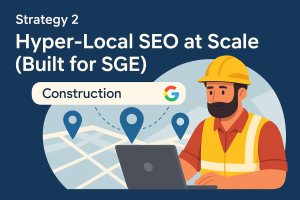
Why This Matters
Construction is inherently local. Homeowners, landlords, councils, and developers don’t just search for “builder”—they search for “builder in Leeds” or “loft conversion specialist Brixton”. In 2025, this behaviour has only intensified thanks to Google’s Search Generative Experience (SGE), which prioritises hyper-specific, intent-driven results.
If your site doesn’t clearly demonstrate service + location relevance, you’ll never appear in the AI-generated summaries or map packs where most decisions are now made. Ranking for “construction company UK” is pointless; ranking for “garage conversion in Manchester” is where the real jobs come from.
The Problem
Most construction websites fall into the trap of creating a single “Areas We Cover” page with a list of towns. This doesn’t work anymore. These pages are:
-
Too thin — just a list of towns with no real content.
-
Not unique — they use the same copy for each location.
-
Unhelpful to users — no examples, pricing, or FAQs specific to that area.
The result? They don’t rank, they don’t convert, and clients end up clicking on competitors who have more targeted content.
The Solution
Step 1: Build Location + Service Landing Pages
Instead of one generic page, create individual landing pages that match the way people search. Each page should target a specific service in a specific area, like:
-
“Loft Conversions in Croydon”
-
“Emergency Roof Repairs in Bromley”
-
“Kitchen Extensions in Leeds”
These pages must include real detail, not just copy-pasted fluff. Add:
-
Local project photos (ideally with the location mentioned in captions).
-
Pricing ranges relevant to that service and area.
-
Common planning rules or restrictions in that council.
-
Testimonials from local clients.
-
An FAQ section tailored to the service and town.
Step 2: Tailor by Trade
-
Builders: Write content like “Average costs for an extension in [Town]” and mention relevant planning permissions.
-
Roofers: Include details on materials (EPDM, GRP, slate) and how local weather impacts roofs in that area.
-
Electricians: Add compliance notes, like EICR requirements for landlords in that city.
-
Plumbers: Highlight emergency response times and common local issues (e.g., hard water areas).
-
Developers: Write case studies about regeneration schemes or planning approvals in the borough.
-
Suppliers: Create service pages like “Timber supplies in Maidstone—same-day collection available.”
Step 3: Enhance with Schema Markup
Use structured data so Google understands what each page is about. For example:
-
Service schema for “Roof repairs” pages.
-
Local business schema with area served.
-
FAQ schema to appear in rich snippets.
-
Project schema to highlight case studies.
Step 4: Publish Micro-Blogs Tied to Local Trends
Create short updates around local triggers:
-
Storm damage (“Roof repairs after [Town] storm: what you need to know”).
-
Planning approvals (“Green light for 200-home scheme in [City]: what it means for builders”).
-
Seasonal needs (“Winter boiler servicing in [Town]—book early to avoid delays”).
These micro-blogs establish authority, improve topical relevance, and make your content look fresh and local—a key ranking factor in 2025.
Step 5: Internal Linking Strategy
Link all local service pages back to your main service pages and case studies. Example:
-
“Extensions in Croydon” → links to “Home Extensions” service page + “Extension project in Croydon” case study.
This web of internal links helps both users and Google understand the hierarchy of your site.
Pro Tip
Don’t try to publish 100 local pages at once—it’ll look thin and forced. Roll out in batches. Start with your highest-priority towns (the ones that actually generate work). Build those out properly with photos, reviews, and FAQs. Once they’re ranking, add more areas. Quality beats quantity.
Key Takeaway
Generic “Areas We Cover” pages won’t win in 2025. To dominate hyper-local search, you need service + location pages with genuine depth, tailored content for each trade, schema markup, and fresh updates tied to real events. Do this right, and you’ll appear not just in the map pack but also in Google’s AI-powered summaries—putting your construction business ahead of competitors who are still stuck in 2019.
Strategy 3: Conversion Infrastructure (Make Enquiries Effortless)
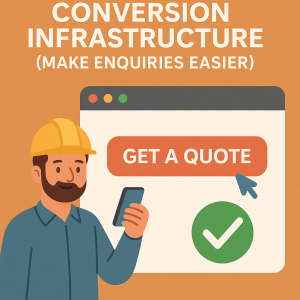
Why This Matters
In construction, leads are time-sensitive. A homeowner with a leaking roof, a landlord needing an urgent boiler replacement, or a developer searching for an architect doesn’t want to browse for long—they want answers, prices, and reassurance now.
That means it’s not enough to drive traffic. If your website makes it difficult to enquire, you’re losing jobs to competitors who provide a smoother path to action. A flashy website is worthless if visitors can’t instantly book, call, or request a quote.
In 2025, the average consumer expects frictionless interaction: one click to call, instant messaging options, and clear forms. If your construction site still relies on buried phone numbers and clunky contact forms, you’re essentially shutting the door on clients.
The Problem
Most construction websites suffer from the same conversion-killing issues:
-
Generic contact forms: A single “Contact us” page with 8 required fields (often left blank).
-
Poor mobile UX: Forms too long to fill in on a phone, no sticky CTA buttons, and no tap-to-call option.
-
Hidden or inconsistent CTAs: Visitors scroll endlessly before finding how to book.
-
Slow response times: Even when forms are filled, enquiries sit unanswered for days.
-
No instant quoting tools: Clients want to know rough costs before committing.
These issues mean that even if you rank #1 on Google, many of your visitors will bounce to competitors who make the process easier.
The Solution
Step 1: Persistent Call-to-Action (CTA)
-
Add a sticky header or footer bar with key CTAs like “Get a Free Quote,” “Call 24/7,” or “Book a Survey.”
-
For emergency trades (roofers, plumbers, electricians), a click-to-call button is essential—especially on mobile.
-
For developers and architects, use “Download Brochure” or “Book Consultation” as CTAs to match their client journey.
Step 2: Instant Quote Tools
Instant quotes can double conversion rates. They don’t need to be exact—they just need to give potential clients confidence. Examples:
-
Roofers: “Upload a photo of your roof + postcode → instant repair estimate.”
-
Builders: “Extension cost calculator: select size, finish, and timeline → ballpark price.”
-
Electricians/Plumbers: “Choose service (rewire, boiler, EICR) → get indicative cost and availability.”
-
Suppliers: Trade calculators that provide instant material pricing by m², weight, or quantity.
Step 3: Smart Booking Systems
Replace back-and-forth emails with online booking:
-
Embed tools like Calendly or YouCanBookMe so clients can directly schedule surveys or consultations.
-
Sync with your calendar so available slots update automatically.
-
Add service-specific booking (e.g., “Book a 30-minute loft survey” vs. “Book an emergency boiler call-out”).
Step 4: Live Chat & Messaging
-
Add WhatsApp for Business integration with a click-to-chat button.
-
Use AI chatbots to pre-qualify leads:
-
“What service do you need?”
-
“Where is the property located?”
-
“When do you need the job done?”
-
-
Route urgent enquiries instantly to a mobile device so someone always responds.
Step 5: Trade-Specific Forms
Generic “Name, Email, Message” forms don’t work for construction. Customise them:
-
Builders: “Type of project? (extension, loft, renovation)” + “Budget range?”
-
Roofers: “Roof type? (tile, slate, flat)” + “Urgency? (today, this week, not urgent).”
-
Electricians/Plumbers: “Emergency? Y/N” → If Yes, show emergency contact number.
-
Developers: “Project size (units/m²)” + “Investor stage (planning, funding, marketing).”
-
Suppliers: “Business type?” + “Do you need trade account setup?”
Step 6: Response Automation
-
Send auto-reply confirmations via email/SMS: “Thanks for enquiring—we’ll call you within 30 minutes.”
-
For urgent trades, use call-forwarding to ensure a human responds instantly.
-
For developers, auto-send a brochure or case study PDF when someone enquires.
Pro Tip
Track micro-conversions (form starts, button clicks, file uploads) as well as final leads. Often you’ll find small tweaks—like reducing form fields or moving CTAs higher—boost enquiries dramatically.
Key Takeaway
A construction website isn’t just a digital brochure—it’s your 24/7 sales rep. By adding persistent CTAs, instant quotes, booking tools, WhatsApp chat, and customised enquiry forms, you transform your site into a conversion machine. The easier you make it for clients to contact you, the more jobs you’ll win—often without spending an extra penny on marketing.
Strategy 4: Video-First Marketing (Shorts, Reels, & Site-Embedded)

Why This Matters
Construction is a visual industry. Clients don’t just want to hear about your skills—they want to see results. Whether it’s a homeowner planning a loft conversion, a developer seeking investor confidence, or a facilities manager comparing roofing contractors, video creates instant trust.
By 2025, video is no longer optional. TikTok, Instagram Reels, and YouTube Shorts dominate online attention, while Google increasingly surfaces video content in AI summaries, map packs, and organic search results. A construction company with strong video assets will always outshine a competitor relying on static images or plain text.
The Problem
Many construction firms sit on an untapped goldmine of content but never use it properly. Typical mistakes include:
-
Posting only still photos of finished projects.
-
No video presence on major platforms like TikTok, Instagram, or YouTube.
-
Long, boring videos instead of short, engaging clips.
-
Failing to repurpose footage—recorded once and never reused.
-
Not embedding videos back into their website for SEO value.
The result? They look outdated, unapproachable, and less credible compared to competitors who showcase their work visually.
The Solution
Step 1: Create Video Content by Trade
Different types of construction businesses can create video content tailored to their audiences:
-
Builders & Roofers: Time-lapse builds, scaffold set-ups, storm damage repairs, before-and-after transformations.
-
Electricians & Plumbers: “Quick tips” clips like “What to do if your breaker keeps tripping” or “How to bleed a radiator before we arrive.”
-
Developers: CGI flythroughs, drone site progress, investor milestone updates, and community engagement videos.
-
Architects: Walkthroughs of 3D designs, materials explainers, or design rationale clips.
-
Suppliers: Product demonstrations, warehouse tours, and “how to choose the right material” videos.
Step 2: Use Short-Form First, Long-Form Later
-
Record 30–60 second clips designed for TikTok, Instagram Reels, and YouTube Shorts. These should be punchy, visually engaging, and include captions.
-
Once you have short-form content, expand the best-performing clips into longer case-study style videos for YouTube and your website.
Step 3: Repurpose Every Shoot
One site visit = multiple pieces of content:
-
1 full-length video showing project progress.
-
5 short clips cut from key moments.
-
Photo stills pulled directly from the footage.
-
BTS (behind-the-scenes) reels of the team at work.
This ensures you always have content to post, even if you only film once per month.
Step 4: Optimise for SEO
Video isn’t just for social media—it fuels your search rankings too:
-
Upload to YouTube with keyword-rich titles like “Loft Conversion in Leeds | Extension Builder Case Study”.
-
Add transcripts so Google can read your content.
-
Embed videos on service and location pages, using VideoObject schema for rich snippets.
-
Link YouTube videos back to your site and service pages.
Step 5: Add Clear CTAs to Videos
Every video should end with a clear next step:
-
“Book your free site survey today.”
-
“Call us now for emergency roofing.”
-
“Download our developer brochure.”
-
“Visit our trade counter for today’s deals.”
This turns viewers into leads, not just likes.
Step 6: Batch Film for Efficiency
Set aside one filming day per month. Capture multiple projects, staff intros, and client testimonials in one go. Then slice that into 10–15 clips to drip-feed across your channels. Consistency beats perfection.
Pro Tip
Use location overlays in your videos. For example, “Kitchen Extension – Harrogate” or “Roof Repairs – Bromley”. This not only builds trust but also boosts local SEO, as Google recognises the relevance between your video and location-based searches.
Key Takeaway
Video-first marketing is the new standard for construction firms in 2025. By creating short, engaging, trade-specific clips, repurposing content efficiently, and optimising for SEO, you’ll build trust faster, rank higher, and win more contracts. Show clients what you can do, and you’ll outshine any competitor still stuck with a static website.
Strategy 5: Reputation Engine (Reviews, Responses, & Repurposing)
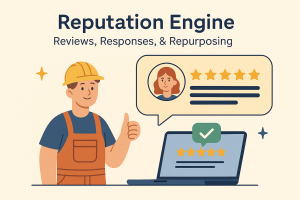
Why This Matters
In construction, trust is everything. Clients aren’t just buying a product—they’re investing thousands (sometimes millions) into projects that can’t afford to go wrong. In 2025, reviews are the digital handshake that convinces people to choose you over a competitor.
From homeowners looking for an emergency plumber to investors vetting a property developer, reviews and testimonials are the deciding factor. Google knows this too, which is why reviews heavily influence Maps rankings, LSAs, and even organic search results. The stronger and more consistent your reputation engine, the more enquiries you’ll generate without increasing ad spend.
The Problem
Many construction companies treat reviews as an afterthought. Common issues include:
-
Few reviews: A roofer with only 3 reviews looks less trustworthy than one with 50+.
-
Inconsistent feedback: Reviews on multiple platforms (Google, Checkatrade, Trustpilot) but no clear strategy.
-
Unanswered negatives: Leaving 1-star reviews unanswered damages credibility.
-
No review integration: Reviews sit on third-party platforms and aren’t showcased on websites.
-
Failure to repurpose: Glowing testimonials often get buried instead of being used in proposals, videos, or social posts.
The result? Missed opportunities, lost leads, and the appearance of being “less established” than competitors.
The Solution
Step 1: Automate Review Collection
-
Send SMS + email requests after every job, with direct links to Google or Trustpilot.
-
Use job management software (like ServiceM8, Jobber, or Tradify) to trigger review requests when projects close.
-
Keep it simple: “Thanks for choosing us. Could you leave a quick review? Here’s the link.”
Step 2: Centralise & Focus on Key Platforms
-
Google Reviews: Prioritise this—it impacts Maps, LSA ranking, and organic search.
-
Checkatrade / Trustpilot: Great for credibility, especially for domestic trades.
-
LinkedIn & Houzz: Useful for architects and developers targeting professionals.
Don’t spread yourself too thin—focus on 1–2 core platforms per trade.
Step 3: Respond to Every Review (Good & Bad)
-
Always reply within 48 hours.
-
Use keywords + location in replies for SEO:
-
“Thanks for the kind words about your loft conversion in Leeds.”
-
-
Handle negatives professionally: acknowledge, explain, and invite the reviewer to resolve offline. A good response can neutralise damage and even win clients’ respect.
Step 4: Showcase Reviews on Your Website
-
Embed live Google Reviews feed on your homepage.
-
Add reviews to service pages: e.g., testimonials on the “Roof Repairs” page.
-
Create a “What Our Clients Say” hub sorted by service and location.
-
Use schema markup so stars appear in organic search.
Step 5: Repurpose Reviews into Powerful Marketing Assets
-
Case Studies: Pair reviews with project photos and results.
-
Social Proof Posts: Turn reviews into branded graphics for LinkedIn, Instagram, or Facebook.
-
Video Testimonials: Record short clips of happy clients—80% more persuasive than text.
-
Proposals & Quotes: Add relevant testimonials to tender documents or investor packs.
Step 6: Encourage Reviews That Mention Services
Generic reviews (“Great job!”) help, but detailed reviews rank better. Encourage clients to mention specific services and areas:
-
“They completed my loft extension in Croydon on time and within budget.”
-
“Emergency call-out plumber in Bromley—arrived within 30 minutes.”
This builds keyword-rich trust signals Google loves.
Step 7: Leverage Reputation for PR & Awards
-
Collect enough positive reviews, and you can enter industry awards (e.g., roofing awards, RIBA recognition).
-
Use strong review scores as part of press releases or council tenders.
-
Highlight metrics: “Rated 4.9/5 from 112 clients in Kent.”
Pro Tip
Use geotagged reviews wherever possible. Encourage clients to leave reviews that mention not just your service but also the specific town or borough. Over time, this builds hyper-local ranking power.
Key Takeaway
Reviews aren’t just nice-to-have—they’re your strongest marketing weapon. A consistent, automated system for collecting, replying to, and repurposing reviews will fuel your SEO, boost conversions, and make clients feel reassured before they even meet you. In construction, trust wins jobs, and in 2025, nothing builds trust faster than visible, verifiable, and well-managed reviews.
Strategy 6: Paid Media That Actually Works in Construction

Why This Matters
Organic SEO and word-of-mouth are powerful, but sometimes construction companies need fast results. Whether it’s filling the pipeline during quieter months, launching a new service, or breaking into a new region, paid media is the quickest way to get in front of clients who are actively searching.
The problem? Most construction firms waste money on generic pay-per-click (PPC) campaigns that target the wrong people. Broad ads for “construction” or “builder” attract tyre-kickers, students doing research, or people outside your service area. Done wrong, paid media drains budgets. Done right, it delivers predictable, high-quality leads at scale.
The Problem
Here’s why most paid campaigns in construction fail:
-
Broad targeting: Ads appear for irrelevant searches (e.g., “construction jobs” instead of “construction company near me”).
-
No lead qualification: Every enquiry costs money, but many are unfit to convert.
-
Poor landing pages: Paid clicks go to generic homepages instead of tailored service pages.
-
Failure to track offline conversions: Agencies report “leads,” but not which leads turned into paying jobs.
-
Over-reliance on one platform: Many firms try only Google Ads and ignore high-performing alternatives like Local Services Ads (LSA), Meta Lead Ads, or even hyper-local Nextdoor placements.
The result? A high cost per lead and frustration that “PPC doesn’t work for builders.”
The Solution
Step 1: Local Services Ads (LSA)
-
Best for: Emergency trades (roofers, plumbers, electricians) where speed matters.
-
How it works: You only pay for valid leads (calls or messages). Google shows your ad with a “Google Screened” badge, which boosts trust.
-
Tips:
-
Narrow your service areas to towns you actually serve.
-
Set bid caps by job type. For example, pay more for “roof replacement” leads than for “gutter cleaning.”
-
Dispute irrelevant leads (e.g., wrong area, job not offered). Refunds are common if you challenge.
-
Step 2: Search & Performance Max (Google Ads)
-
Best for: Builders, developers, and suppliers targeting higher-value, non-emergency projects.
-
Approach:
-
Build single keyword ad groups (SKAGs) targeting intent-driven queries like “loft conversion Croydon” or “timber supplier Kent.”
-
Exclude irrelevant terms like “jobs,” “courses,” or “DIY.”
-
Feed Performance Max campaigns with real assets: photos of projects, videos, testimonials.
-
-
Landing Pages: Never send clicks to your homepage. Create tailored landing pages for each service with a clear CTA.
Step 3: Meta Lead Ads (Facebook & Instagram)
-
Best for: Trades and suppliers targeting homeowners or small developers.
-
How it works: Users fill in a pre-populated form without leaving the platform.
-
Tips:
-
Qualify leads with 2–3 smart questions (“When do you plan to start?” / “What’s your postcode?”).
-
Add calendar handoff: integrate with Calendly so clients can book surveys directly.
-
Use local imagery—show your vans, team, or actual jobs in your area.
-
Step 4: LinkedIn Ads for B2B Construction
-
Best for: Developers, architects, and suppliers targeting investors, councils, or main contractors.
-
Approach:
-
Run account-based campaigns targeting decision-makers at councils, housing associations, or construction groups.
-
Promote case studies, ESG achievements, or investor milestones.
-
Use retargeting to stay visible after tender submissions.
-
Step 5: Hyper-Local Ads (Nextdoor, Waze, Display)
-
Nextdoor Ads: Excellent for roofers, builders, and landscapers. Homeowners already discuss local recommendations—your ad sits in the feed where trust is built.
-
Waze Ads: Perfect for suppliers—target drivers near builder’s merchants or trade counters.
-
Geo-Fencing: Target ads around planning-application hotspots, storm-hit postcodes, or competitor trade counters.
Step 6: Retargeting Campaigns
-
Many prospects don’t enquire on their first visit. Retargeting brings them back:
-
Show ads to people who visited your site but didn’t convert.
-
Target people who watched 50%+ of your videos.
-
Use GBP clickers (people who hit “Website” from Maps but didn’t call).
-
Step 7: Offline Conversion Tracking
The biggest gap in construction paid media is tracking real outcomes. Fix it by:
-
Using call tracking numbers by channel.
-
Logging every enquiry in a CRM (HubSpot, Zoho, or even a spreadsheet).
-
Importing won jobs back into Google Ads and Meta so algorithms learn what a good lead looks like.
-
Example: If a £30k extension enquiry converts, teach Google to find more of those, not tyre-kickers asking about £200 jobs.
Pro Tip
Always split campaigns by service type and location. Don’t lump “roof repairs” with “roof replacements.” Different intent = different value. When you track them separately, you’ll see which jobs are truly profitable.
Key Takeaway
Paid media for construction works brilliantly when it’s laser-targeted. Local Services Ads capture urgent calls, Google Search and Performance Max drive project enquiries, Meta and LinkedIn nurture leads, and hyper-local platforms keep you visible where it matters. Layer this with strong retargeting and offline conversion tracking, and you’ll finally know where every pound goes—and which channels deliver real jobs.
Strategy 7: Digital PR, Partnerships & Local Authority
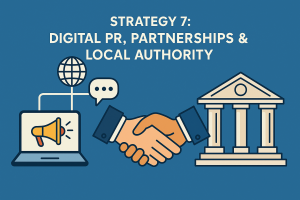
Why This Matters
In 2025, credibility is currency for construction firms. A strong online presence isn’t just about your own website or ads—it’s about how often your business is mentioned and trusted by third-party sources. From local newspapers and trade associations to council websites and supplier partnerships, these external signals are what separate “just another contractor” from an established authority.
Google’s algorithms place huge weight on these credibility signals. Backlinks from trusted sites boost rankings. Mentions in press stories improve brand recognition. Case studies on partner websites bring referral traffic. For developers and architects, PR and partnerships can even make the difference between securing planning approval or being overlooked by investors.
The Problem
Many construction firms ignore PR entirely, assuming it’s only for big corporations. But this leaves opportunities on the table:
-
No media presence: Firms don’t pitch to local papers or trade publications.
-
Missed partnerships: Contractors and suppliers work together offline but never link to each other online.
-
Poor reputation management: Press is only considered when something goes wrong.
-
Underused awards: Few enter industry awards, even though shortlisting alone creates credibility.
-
Council silence: Developers and architects often don’t share community consultation updates online, missing chances to link with local authority websites.
Without these authority signals, even the best SEO campaigns struggle to achieve long-term rankings.
The Solution
Step 1: Pitch Local Press with Human Stories
-
Councils and newspapers love community angles. Instead of “we built a house extension,” pitch stories like:
-
“Local builder takes on 2 apprentices in Croydon to tackle skills gap.”
-
“Roofing firm helps storm-hit families repair homes within 48 hours.”
-
“Developer pledges £250k community fund alongside regeneration project.”
-
-
Add photos and quotes from the client or local residents to increase pick-up.
-
Always link the press story back to your website with a case study page for SEO.
Step 2: Build a Backlink Network Through Partnerships
-
Suppliers: If you buy from a local builder’s merchant, ask to be listed as a “trusted contractor” on their website. In return, link to them from your site.
-
Subcontractors: Create “Our Partners” pages showcasing electricians, plumbers, or scaffolders you work with—and encourage them to do the same.
-
Architects & Developers: Collaborate on case studies that both parties publish, creating two high-quality backlinks per project.
-
Trade Associations: Join groups like FMB, RIBA, or NICEIC and ensure your profile links back to your site.
Step 3: Enter Industry Awards
-
Awards are marketing gold—even being shortlisted creates credibility. Examples:
-
NHBC Awards (builders)
-
RICS Awards (developers, surveyors)
-
CIOB Construction Awards (contractors)
-
RIBA Awards (architects)
-
-
Publish blog posts and press releases about nominations, and add award logos to your website.
Step 4: Publish Project Microsites & Press Kits
-
For large developments or regeneration schemes, create a standalone microsite (e.g., [town]regeneration.co.uk).
-
Include: project timeline, stakeholder updates, planning approval documents, and downloadable press kits.
-
Link back to your main website. This boosts visibility and makes it easier for journalists and councils to cite your work.
Step 5: Leverage Local Authority & Council Links
-
Host community consultation updates on your site and ask councils to link to them.
-
Provide progress updates that can be embedded in council newsletters or planning portals.
-
This earns .gov.uk backlinks, some of the strongest signals you can get.
Step 6: Repurpose PR Wins Across Channels
-
Convert press mentions into branded graphics for LinkedIn.
-
Add a “Featured In” section to your homepage with logos of publications.
-
Turn award shortlists into blog posts, newsletters, and social ads.
-
Use authority mentions as proof in tender documents and investor packs.
Pro Tip
Don’t just chase big national media—start small. Regional newspapers, trade blogs, and council pages are easier to secure, more relevant for local SEO, and often more trusted by the communities you serve.
Key Takeaway
PR and partnerships aren’t just for big names. By pitching community-focused stories, building backlink networks with partners, entering awards, and securing links from councils and trade bodies, construction companies of any size can build authority that Google and clients trust. In 2025, these authority signals are the difference between being invisible and being the obvious first choice.
Strategy 8: AI, Automation & Measurement for 2025

Why This Matters
In 2025, construction marketing is no longer just about getting leads—it’s about getting the right leads, at the right cost, with minimal manual effort. With ad prices rising, cookies disappearing, and Google shifting toward AI-powered search, businesses that don’t adopt automation and advanced measurement risk falling behind.
AI and automation aren’t about replacing people; they’re about removing bottlenecks. Imagine if enquiries were answered instantly, quotes were half-written before you touched the keyboard, and you knew exactly which channels brought in profitable jobs. That’s the power of a properly set up automation and measurement system.
The Problem
Most construction companies face the same recurring issues when it comes to digital efficiency:
-
Slow response times: Leads sit unacknowledged for hours or days, by which point they’ve already called competitors.
-
Manual quoting: Every job requires time-consuming back-and-forth, even for routine enquiries.
-
Leaky tracking: Companies know how many calls they get, but not which marketing channel produced them.
-
Wasted ad spend: Algorithms optimise for clicks or cheap leads, not paying jobs, because no offline conversion data is fed back.
-
Lack of first-party data: With third-party cookies disappearing, many firms aren’t collecting customer data in a way they can control.
The result? Higher costs, fewer conversions, and less time for actual project delivery.
The Solution
Step 1: CRM Automation
-
Set up a CRM system (HubSpot, Zoho, Pipedrive, or even Tradify/Jobber for trades).
-
Every lead (from forms, WhatsApp, GBP, LSA, calls) should flow into one dashboard.
-
Automate responses:
-
Builders: “Thanks for your enquiry about an extension. We’ll call within 30 mins to discuss.”
-
Roofers: “Emergency enquiry received. Engineer on the way—ETA 1 hour.”
-
Suppliers: “Thanks for requesting a trade account. Here’s our product catalogue.”
-
This gives clients instant reassurance and buys your team time.
Step 2: AI Quote Assistance
-
Use AI to draft quotes from inputs like project type, size, postcode, and uploaded photos.
-
Example:
-
A homeowner uploads photos of a leaking roof. The AI pulls in your standard pricing, inserts description of likely materials, and drafts a PDF quote. You check, adjust, and send in minutes—not hours.
-
-
For developers, AI can pre-fill investor packs with ROI models and project data.
Step 3: First-Party Data Capture
-
Add lead magnets to your site: “Download our free loft conversion cost guide 2025.”
-
Collect names, emails, and postcodes in exchange.
-
Store this in your CRM, building a database you own—crucial as ads move away from cookie-based targeting.
Step 4: Advanced Tracking & Attribution
-
Implement server-side tracking in GA4 and Consent Mode v2 to maintain accurate data under GDPR.
-
Use call tracking numbers per channel:
-
One for GBP.
-
One for LSAs.
-
One for website.
-
-
Log outcomes: quote sent, job won, value of contract.
-
Import this data back into Google Ads and Meta, so the algorithms optimise for profitable jobs, not just leads.
Step 5: Offline Conversion Imports
-
Example: A £25k extension enquiry that originated from Google Ads should be fed back into Google. That way, Google finds more of those, instead of optimising for £100 handyman jobs.
-
Set up automated workflows so every “Job Won” in your CRM sends back to ad platforms.
Step 6: Dashboards for Real-Time Insights
-
Build a Looker Studio dashboard showing:
-
Enquiries by channel.
-
Cost per lead.
-
Conversion rate.
-
Revenue per channel.
-
-
Split by trade type (extensions, lofts, roofing, plumbing).
-
Example: You may discover Google LSAs drive cheap roofing leads, but extensions only close from organic SEO + retargeting ads.
Step 7: Automate Review Requests
-
Link CRM to review platforms (Google, Trustpilot, Checkatrade).
-
When a job closes, an SMS/email goes out: “Thanks for choosing us. Could you leave a quick review?”
-
This keeps your reputation engine flowing without manual chasing.
Pro Tip
Use QR codes on site boards, vans, and brochures with tracking links. That way, when someone scans the code to get in touch, you know exactly where that enquiry came from. It’s a simple hack to bridge offline and online tracking.
Key Takeaway
AI, automation, and measurement aren’t futuristic luxuries—they’re essentials for construction businesses in 2025. By responding instantly, drafting quotes automatically, tracking every conversion, and teaching ad platforms what a profitable lead looks like, you’ll reduce waste, free up time, and consistently fill your pipeline with jobs worth winning.
Turning Strategy into Action
Online marketing for construction companies in 2025 doesn’t need to feel overwhelming. Yes, the landscape is crowded, competitive, and constantly shifting, but the businesses that win are those that focus on clarity, trust, and visibility.
This guide has shown you how Google Business Profiles and LSAs bring in urgent leads, how hyper-local SEO wins long-term visibility, why strong CTAs and instant quoting tools boost conversions, and how video, reviews, and PR build trust faster than any advert ever could. We’ve also covered smarter paid campaigns and the role of automation in keeping costs down while keeping pipelines full.
The good news? You don’t have to implement everything at once to see results. A few small actions taken today can start moving the needle:
-
Optimise your Google Business Profile by adding new photos, updating services, and requesting reviews.
-
Add a clear CTA (“Request a Quote” or “Call Now”) at the top of your website.
-
Record a short video of your latest project and upload it to Google Posts or Instagram Reels.
-
Ask one happy client to leave a detailed review mentioning the service and location.
-
Track one conversion metric—calls, forms, or bookings—and monitor it weekly.
These are quick wins that build momentum while you work on the bigger strategies like SEO at scale, reputation systems, and automation.
At its core, effective online marketing in construction is about making it easy for clients to find you, trust you, and contact you. Start with the simplest steps today, and you’ll already be ahead of competitors still relying on word-of-mouth alone.


